Smart Vision for Managed Home Care
Jackson Dean Goodwin
Dept. of Computer Science
University of Tennessee at Chattanooga
Chattanooga, TN 37403
mwq755@mocs.utc.edu
Abstract—With an increasing number of elderly living alone, it
becomes a challenge to ensure their safety and quality of life
while maintaining their independence. The aim of this research is
to investigate a new software system for pervasive home
monitoring using smart vision techniques. In-home activity
monitoring can provide useful information to doctors in areas
such as behavior profiling, and preventive care. It can also
facilitate in emergency detection and remote assistance. The
proposed solution uses an inexpensive webcam and a computer
program to analyze posture using techniques such as foreground
detection and ellipse fitting. This paper will describe the merits
and challenges of using computer vision as a solution to
monitoring and evaluating daily activities of the elderly.
Index Terms—elderly care, activity monitoring, computer
vision.
I. INTRODUCTION
As life expectancy continues to increase, so does the demand
for elderly care. Most elders would prefer to live in their own
homes, but the gradual loss of functioning ability often causes
these individuals to require some sort of assisted living or long
term care such as that found in a nursing home. Pervasive
home monitoring could afford elders a certain level of security
and improvement in quality of life while maintaining their
independence and privacy. Low-cost vision-based systems can
be used to monitor and evaluate daily activities of the
occupants.
The ultimate goal of this research is to develop methods for
analyzing the motion of an individual in a scene in order to
extract information about the person’s posture, behavior, and
activity. Major research questions include how to separate the
individual from the scene, how to detect posture, and how to
ensure privacy. In this paper, we focus on methods for
detecting foreground, detecting humans in the foreground, and
detecting posture, so that we can monitor activity and behavior.
II. MOTIVATIONS
Individuals with poor postural stability who do not need
assistance with activities of daily living can benefit the most
from a low-cost vision-based home monitoring system. Such a
system would allow these individuals to remain at home and
continue regular activities without incurring expenses and loss
of privacy or
from hiring a healthcare
professional to be in the home.
independence
The cost of providing such a monitoring system is less than
the cost of hiring a caregiver or living in a nursing home. Costs
for care range from $70 a day at an adult day health care center,
to $200 a day for a semi-private room in a nursing home. Costs
for an in-home pervasive monitoring system would be a one-
time investment of about $500 for several wireless cameras
(and possibly other devices beyond the scope of this project),
and $1200 for a computer base/processing unit. Then there
would be an additional cost of about $30 per day. The up-front
cost for a monitoring system would be more, but it would
match the price of adult day health care in 45 days (in 25 days
for assisted living and in 12 days for a nursing home).
Monitoring systems can also provide more privacy for the
occupant for two reasons: 1) The occupant can continue to live
alone without disturbance, and 2) Identifying features from the
cameras can be removed programmatically. The computer does
virtually all of the analysis, so the only time anyone would
access images from the cameras would be in an emergency that
required further examination of the situation.
III. RELATED WORK
Researchers at the Wireless Sensor Networks Lab at
Stanford University have developed a system [1] for
monitoring elderly persons remotely. They make use of a
wireless badge containing accelerometers to detect a signal
indicating a fall. Wireless signal strength is used to triangulate
an approximate location to trigger cameras with the best views
when a fall occurs. Each camera processes
the scene
independently to identify whether a human body exists in the
image. The scene is first analyzed to detect motion events
through
the use of background subtraction and blob
segmentation. Blobs are further classified as human or non-
human by analyzing the percentage of straight edges and skin
color in each blob. If the blob is a human, the posture and head
position is estimated and a certainty level is reached by each
camera based on the consistency of the obtained results.
Posture is analyzed by fitting an ellipse on the blob and
analyzing the orientations of the major and minor axes. The
head is detected using skin color or shoulder-neck profile or
both. Through collaborative reasoning among several cameras,
a final decision is made about the state of the user. This work
addresses the issue of reliability of results by making use of
different camera views, reducing the number of false alarms
and increasing efficiency.
�
Tarik Taleb et. al. present a framework [2] for assisting
elders at home called ANGELAH, which is a middleware
solution integrating elder monitoring, emergency detection, and
networking. It enables efficient integration between a variety of
sensors and actuators deployed at home for emergency
detection and provides a solid framework for creating and
managing rescue teams composed of individuals willing to
promptly assist elders in case of emergency situations. This
work discussed issues relating to elder support group formation.
Researchers at
the
Imperial College London have
developed a ubiquitous sensing system [3] for behavior
profiling. This system uses vision based activity monitoring for
activity recognition and fall detection. To circumvent privacy
issues, their vision-based system filters captured images at the
device level into blobs, which only encapsulate the shape
outline and motion vectors of the subject. To analyze the
activity of the subject, the position, gait, posture and movement
of the blobs in the image sequences are tracked. This subject-
specific information is called personal metrics. The basic goal
of their system was to measure variables from individuals
during their daily activities in order to capture deviations of
gait, activity, and posture to facilitate timely intervention or
provide automatic alert in emergency cases. The posture is
estimated by fusing multiple cues, such as projection histogram
and elliptical fitting, obtained from the blobs and comparing
with reference patterns. From the posture estimation results,
activity can be accurately determined. This system can also
determine different types of walking gaits and decide whether
the user has deviated from the usual walking pattern. The main
issues covered in this work are ensuring privacy by filtering
captured images at the device level, and using personal metrics
to profile behavior.
IV. PROPOSED APPROACH
The focus of this research is on behavior profiling through
the use of smart vision techniques. First, posture must be
detected and then changes in the posture over time can be
analyzed to detect events and evaluate activity. We wrote a
computer program that detects posture in real time from
streaming video. Much of the image processing was done using
the algorithms already provided in the OpenCV library. The
input for this program is provided by a camera, and the output
is intended to be a description of the person's activity. The
activity is in terms of how much time was spent standing up,
walking, sitting down, lying down, etc. This system could also
be used to alert caregivers to a fall. So far, the program only
differentiates between three activities (standing, sitting, lying
down) and fall detection is not implemented.
Foreground Detection. The first step was to separate the
foreground from the background. Generally, the foreground is
everything that is either moving or new, and the background is
everything else that does not move and does not change.
Foreground is the part of the image that is of interest, since it is
the only place where a human should appear. Figure 1
illustrates the concept of foreground and background.
Fig. 1. A classroom serves as the background (left). The author becomes the
foreground when he enters and stands in the room (center). The foreground is
shown in white, and background is shown in black (right). Note that the
shadow is also detected as foreground.
There are several ways to detect foreground. One way is to
simply subtract each frame of video from its immediate
predecessor. This is called frame differencing. This method has
its drawbacks as it only works for detecting objects that are
currently in motion, and it generally only detects the outlines of
objects. A more sophisticated way to detect foreground is to
create a model of the background and compare images from
each frame to the background model. This is the method that
we have implemented.
In order to create the background model, our program first
goes through calibration. This process lasts about 15 seconds,
and creates several background models, each corresponding to
a different exposure level of the camera. This allows for the
program to adjust to changing lighting conditions and to
automatically choose the best exposure for the scene at any
void calibrate()
{
convertToHSLColorSpace
(the frame from the camera);
convertToAFloatingPointScale
(the image from the previous line);
findTheSumOfTheAccumulatedFramesAnd
(the current frame);
make a backup of the background model;
if (it is time to check the exposure)
{
detectForeground(); // see figure 3
detectSkin();
determinePercentageOfForegroundIn
(the foreground image);
if(the percentage of foreground in the
image > the threshold)
{
Revert to the old background model;
stop calibrating;
}
else
{
increase the exposure;
if(we have gone through all of the
{
stop calibrating;
}
}
}
}
exposures)
moment.
Fig. 2. Pseudocode for the calibration algorithm
�
Sometimes the background model becomes invalid. Such is
the case when the lighting in a room changes and when the
camera is moved. Other times, the background may be valid,
but there is no detected foreground (i.e. no one is in the scene).
In this case, it would be useful to recalibrate the scene in case
there have been any changes to the background since the
person left. For these reasons the program recalibrates when
either: a) There is not much in the foreground (which implies
that there is no one in the room), or b) there is too much in the
foreground (which implies that the lighting in the room has
changed, the camera has moved, or the background model is no
longer accurate).
Once we have a background model, we can detect
foreground by finding the difference between the model and
the current frame of video. This is done by finding the absolute
value of the difference between the components of the model
and the components of the current frame, and then applying a
threshold. The threshold is used to make a binary image (i.e.
one whose pixels are either white or black – foreground or not
foreground) out of the grayscale image created from the
subtraction of the frames. This process uses the same technique
as the frame differencing method mentioned earlier, but differs
from this method in that the current frame is compared to the
background model instead of the immediately preceding frame.
Once the foreground is detected, an algorithm is applied to the
image to remove noise (i.e. isolated specks and unwanted small
regions) and clean up the edges. This works by applying
opening and closing morphological transformations (which use
dilation and erosion operations) and by removing contours that
are too small to be important.
void detectForeground()
{
convertToHSLColorSpace
(the frame from the camera);
splitIntoIndividualImagesForEachChannel
(the frame from the camera);
splitIntoIndividualImagesForEachChannel
(the background model);
findTheAbsoluteValueOfTheDifferenceBetween
(each channel of the frame and model);
applyAThresholdTo
(the differences of the frames);
convertFromRGB2GRAY
(the frame from the camera);
combineSingleChannelImagesIntoOneImage
(each of the channels from the frame);
applyAThresholdTo
(the image from the previous line);
removeNoiseFromAndSmooth
(the image from the previous line);
}
Fig. 3. Pseudocode for the foreground detection algorithm
applying a threshold to each of the channels in the RGB color
space tends to detect shadows in addition to detecting real
foreground. Using the HSL color space reduces this effect to a
certain degree, but does not completely eliminate it (see Figure
1 (right) and note).
Regardless of the color space used for foreground detection,
one challenge is dealing with the fact that when a part of the
foreground is similar in color to the corresponding part of the
background model, it is less likely to be detected as foreground.
This can be seen as black lines or shapes appearing where there
should be white foreground.
Human Detection. The next step is to determine whether or
not the foreground “blobs” (i.e. connected regions in the
foreground) are human contours. Human blob detection can be
done by combining the results of detecting the head, the
percentage of skin color, and the percentage of straight lines in
the blob. Each of these factors can be weighed to determine
whether the blob is a human.
The easiest technique to implement is skin color detection.
This can easily be done using the HSL color space by applying
two hue thresholds, an upper and a lower, to define a range of
hues that corresponds to the color of skin. (Hue is a term that
refers to what color something is e.g. red, orange, yellow, green,
cyan, blue, and corresponds to the frequency, or inversely the
wavelength, of light that it appears to be. This is in contrast to
saturation, which means closeness to a pure color versus a
shade of gray, and lightness, which is the perceived intensity,
or brightness of the color.) If a blob has a large enough
percentage of skin color (from the original image), then it has a
greater chance of being a human.
void detectSkin()
{
for(each pixel in the frame from the camera)
{
convertToHSLColorSpace
(the frame from the camera);
if
(the color is within the range of hues
and saturations for skin color)
mark the pixel as skin;
}
}
Fig. 4. Pseudocode for the skin detection algorithm
The next technique we implemented was the straight line
detection. The idea is that manmade objects tend to have
straight-line components, while humans do not. Application of
a threshold to the number of lines detected in the part of the
original image that corresponds to the blob can be used to
determine whether the blob is likely to be a human. The Hough
line transform is used to detect lines in the blobs.
Also, worthy of noting is the fact that we use the HSL (Hue,
Saturation, Lightness) color space for the foreground detection.
The reason for this has to do with the difference between how
computers and humans see color and intensity of light. As it
applies to foreground detection, the RGB (Red, Green, Blue)
color space is very sensitive to changes in brightness. Therefore,
�
void detectLines()
{
detect edges in the frame from the camera;
detect lines that lie within the
foreground region with the Hough line transform;
if(there are fewer than x lines in the
foreground)
increase the probability that
the blob is a human;
}
Fig. 5. Pseudocode for the line detection algorithm
The last technique for human detection is head detection.
This is the most complex and probably the most decisive factor
in detecting a human body. There are several ways to detect a
head. One way involves skin color and the position of the head
relative to the body, another involves the shape profile of the
head, neck, and shoulders, and another involves complex
analysis of facial features. The technique that we implemented
involved fitting an ellipse around the blob to find the ends of
the body (i.e. the ends of the major axis of the ellipse), and then
calculating the percentage of skin color in a small region
around each end. This relatively crude solution detects the head
most of the time when the blob is a human, but can fail when
the person is not facing the camera. Figure 7 depicts a couple
of the steps involved in human detection.
void detectHead()
{
detect the contour of each blob;
fit an ellipse around the contour;
find the ends of the major axis;
detect the percentage of skin color in a
small region around each end;
if(that percentage > x)
a head has been detected;
}
Fig. 6. Pseudocode for the head detection algorithm
Fig. 7. Skin color detected in the blob (left). Ellipse fitted around blob to
locate the head (right).
Posture Detection. Next, posture can be determined from
the lengths and orientation of the axes of the ellipse fitted
around the blob. The algorithm that we implemented to do this
is very simple. If the ellipse is taller than it is wide, the person
is either standing or sitting. If the ratio of the longer axis to the
smaller axis is below a certain threshold, then the person is
sitting. Otherwise, the person is lying down.
[1]
A. Keshavarz, A. M. Tabar, and H. Aghajan,
"Distributed vision-based reasoning for smart home
care," 2006.
V. RESULTS
The foreground detection will still detect shadows,
especially if one stands near a wall or some other vertical
surface. The detection of shadows will usually cause the
program to report that the user is sitting down when he is
really standing up near a wall. Also, extending the arms out to
the side will change the shape of the ellipse being fitted
around the body, and will cause the program to report that the
person
the
background that are about the same color as the object in the
same position in the real foreground will not show up in the
detected foreground, because the difference in color does not
exceed the threshold. The human detection algorithm is
rudimentary and does not always filter out non-human objects.
is sitting down. Occasionally, objects
in
VI. FUTURE WORK
Much more can be done in the way of human detection,
especially with the head detection. A shoulder-neck profile
algorithm or a facial feature detection algorithm would yield
much more accurate results, but would also be more difficult
to implement. Optimization of the HSL color space or use of
another color space may produce more accurate results as well.
A more robust foreground detection algorithm could better
handle slight changes in lighting, such as that caused by
changes in ambient light as from the sun on a partly cloudy
day. Foreground detection could be improved again by not
allowing shadows to appear in the foreground. Finally, more
work can be done in the areas of fall detection, activity
recognition, behavior profiling, and gait analysis to make use
of the posture information.
More can be done to have a quantitative analysis of the
results as well. Most of the data can best be interpreted
through visualization. A confusion matrix can be used to
visualize the performance of this algorithm.
VII. CONCLUSION
The three steps that must be performed before activity can
be analyzed are 1) foreground detection, 2) human detection,
and 3) posture detection. Each of these steps can be taken in
various ways. We spent most of our time working on
foreground detection. As a result, this is the most developed
part of our program. The other steps are no less important, and
can be developed in future work.
ACKNOWLEDGMENT
We would like to thank our professor, Dr. Yu Cao, for
providing the opportunity for us to do this research and for
answering our questions and guiding us along the way.
REFERENCES
[2]
T. Taleb, D. Bottazzi, M. Guizani, and H. Nait-
Charif, "ANGELAH: a framework for assisting
�
elders at home," Selected Areas in Communications,
IEEE Journal on, vol. 27, pp. 480-494, 2009.
B. P. L. Lo, J. L. Wang, and G. Z. Yang, "From
imaging networks to behavior profiling: Ubiquitous
sensing for managed homecare of the elderly,"
2005.
[3]
�
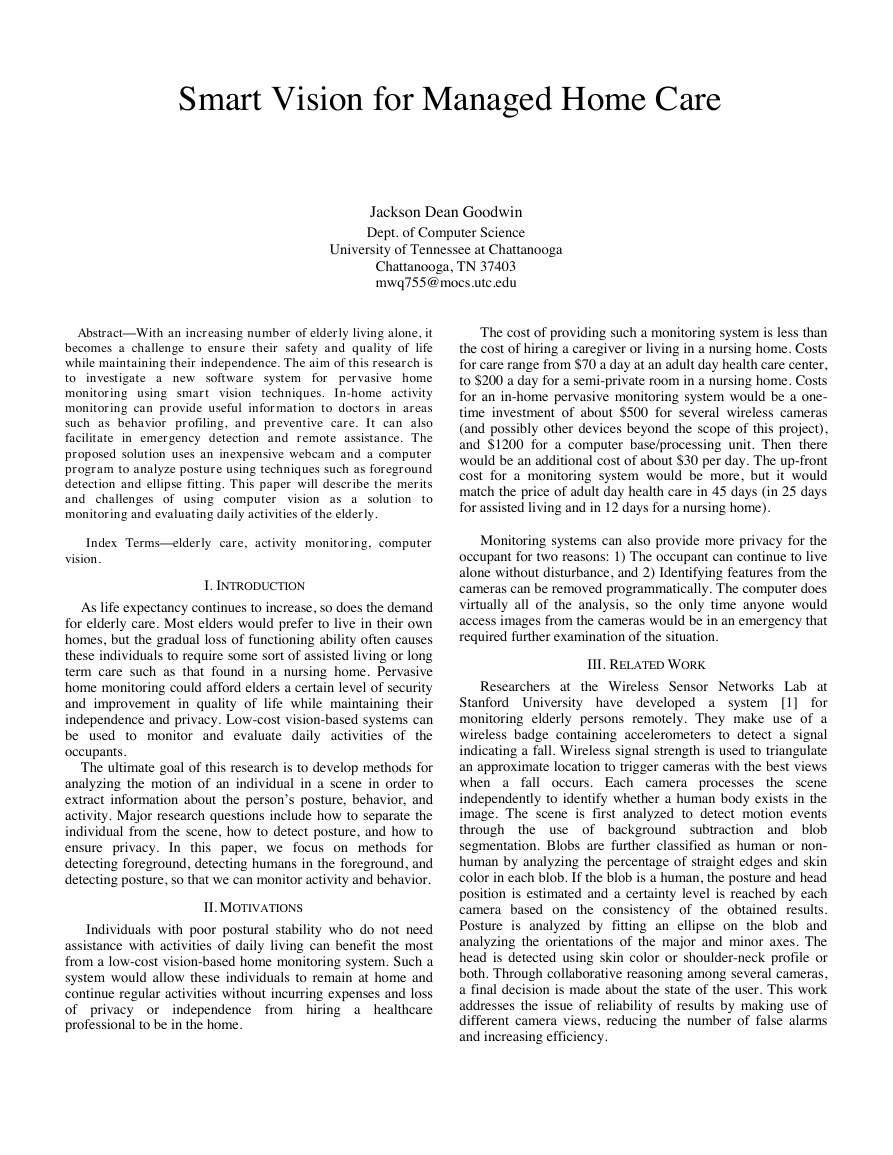
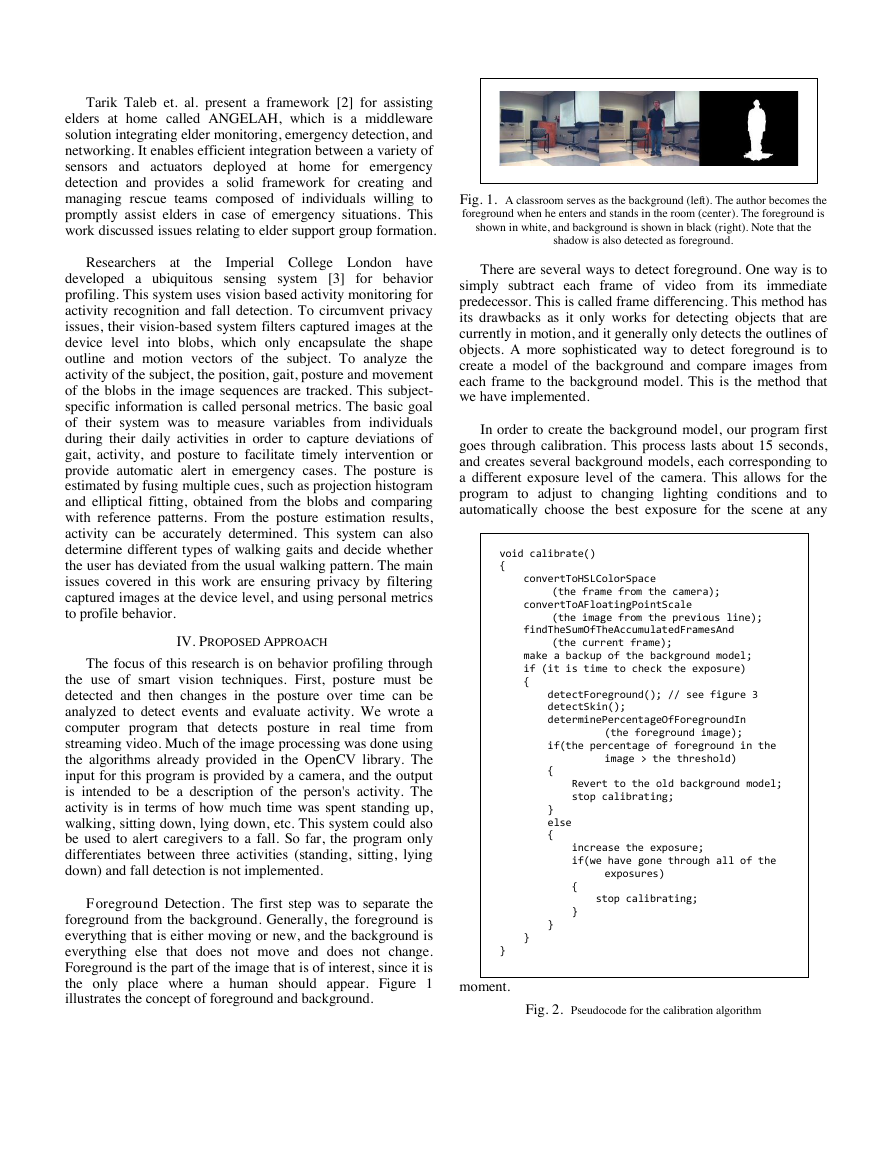
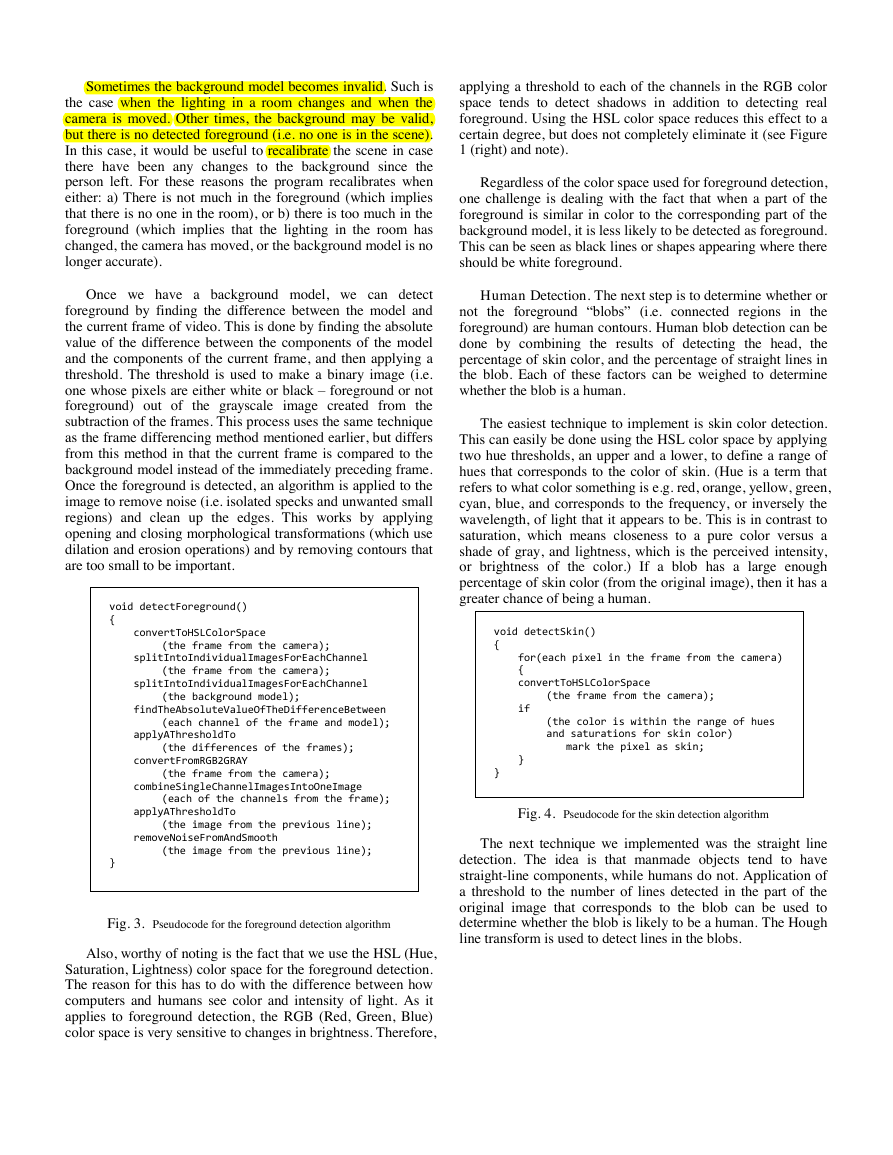
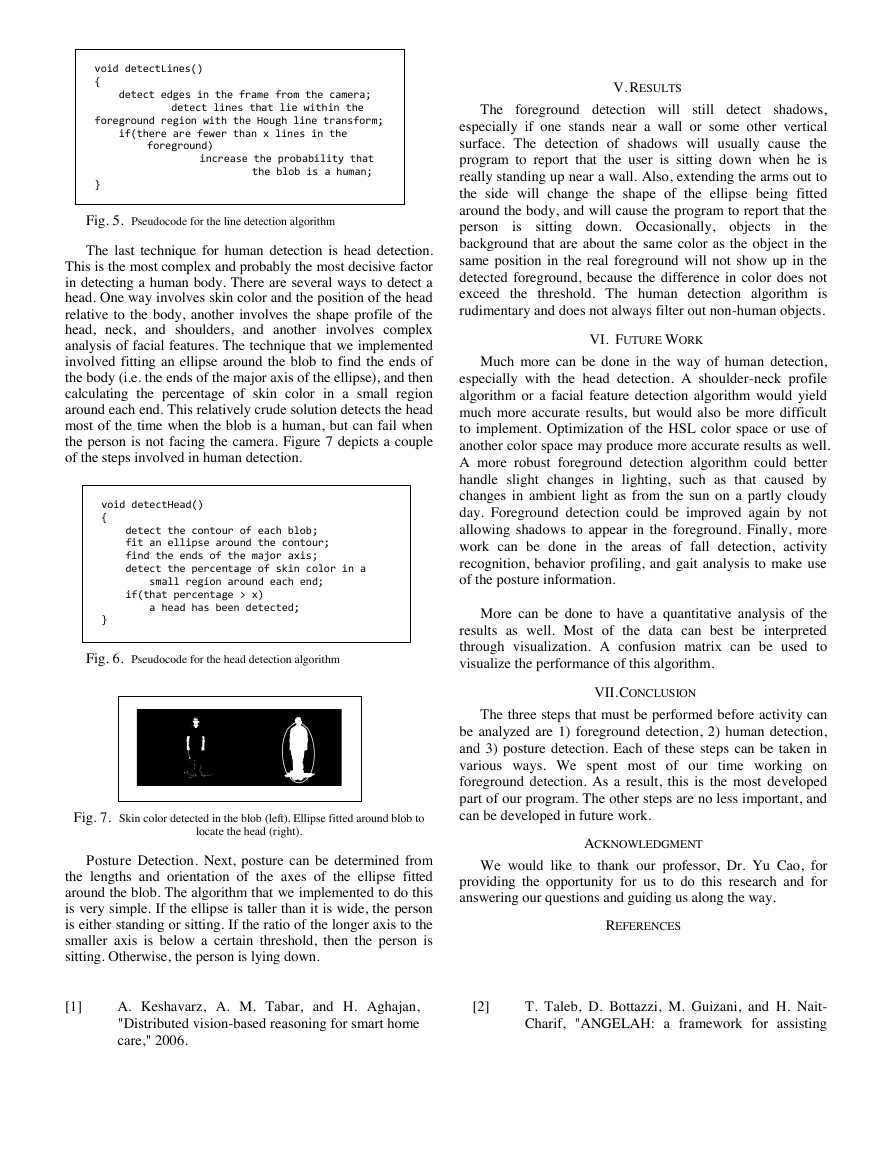
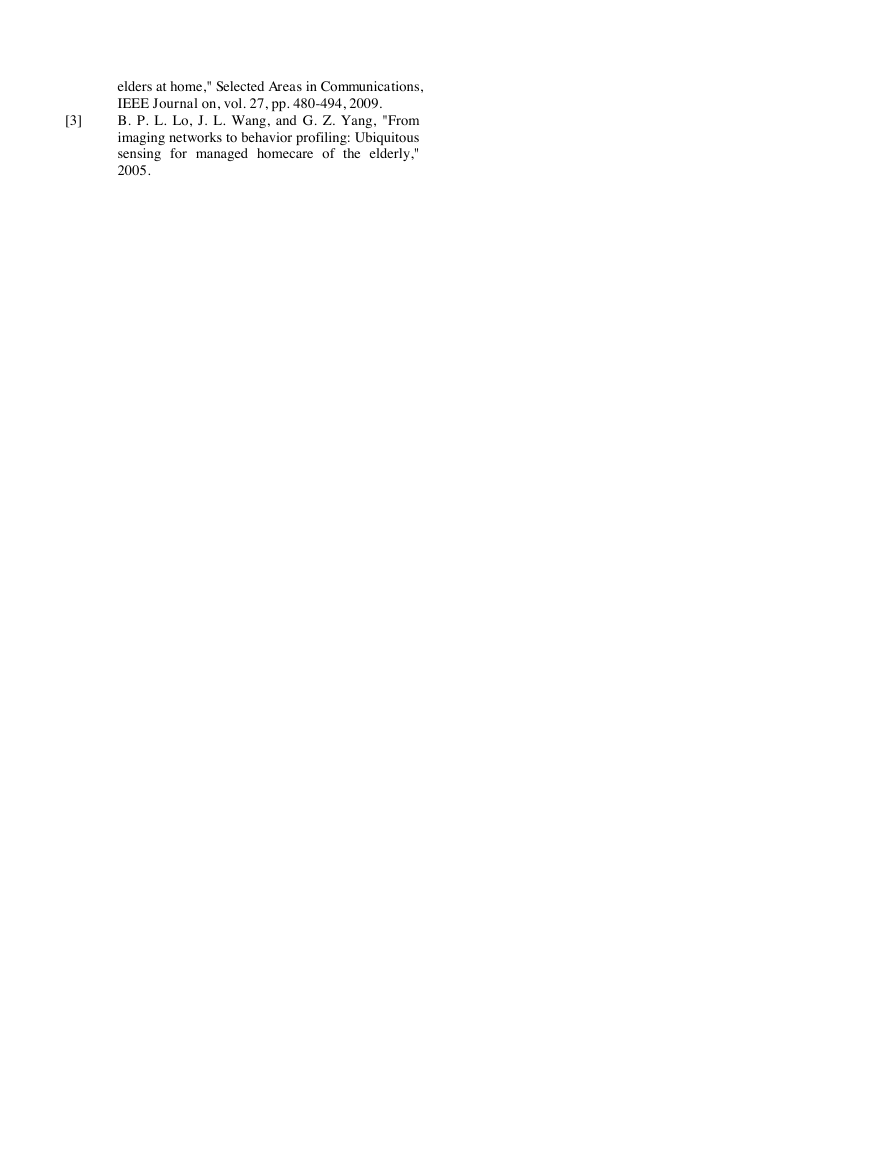





 2023年江西萍乡中考道德与法治真题及答案.doc
2023年江西萍乡中考道德与法治真题及答案.doc 2012年重庆南川中考生物真题及答案.doc
2012年重庆南川中考生物真题及答案.doc 2013年江西师范大学地理学综合及文艺理论基础考研真题.doc
2013年江西师范大学地理学综合及文艺理论基础考研真题.doc 2020年四川甘孜小升初语文真题及答案I卷.doc
2020年四川甘孜小升初语文真题及答案I卷.doc 2020年注册岩土工程师专业基础考试真题及答案.doc
2020年注册岩土工程师专业基础考试真题及答案.doc 2023-2024学年福建省厦门市九年级上学期数学月考试题及答案.doc
2023-2024学年福建省厦门市九年级上学期数学月考试题及答案.doc 2021-2022学年辽宁省沈阳市大东区九年级上学期语文期末试题及答案.doc
2021-2022学年辽宁省沈阳市大东区九年级上学期语文期末试题及答案.doc 2022-2023学年北京东城区初三第一学期物理期末试卷及答案.doc
2022-2023学年北京东城区初三第一学期物理期末试卷及答案.doc 2018上半年江西教师资格初中地理学科知识与教学能力真题及答案.doc
2018上半年江西教师资格初中地理学科知识与教学能力真题及答案.doc 2012年河北国家公务员申论考试真题及答案-省级.doc
2012年河北国家公务员申论考试真题及答案-省级.doc 2020-2021学年江苏省扬州市江都区邵樊片九年级上学期数学第一次质量检测试题及答案.doc
2020-2021学年江苏省扬州市江都区邵樊片九年级上学期数学第一次质量检测试题及答案.doc 2022下半年黑龙江教师资格证中学综合素质真题及答案.doc
2022下半年黑龙江教师资格证中学综合素质真题及答案.doc